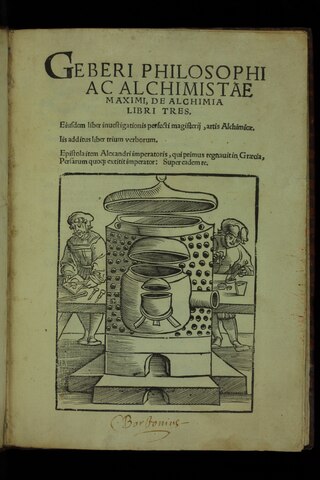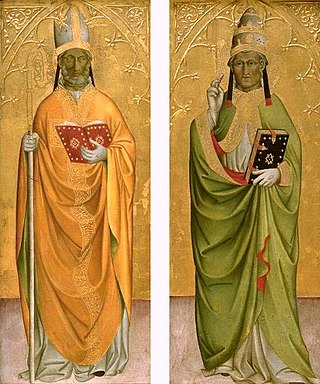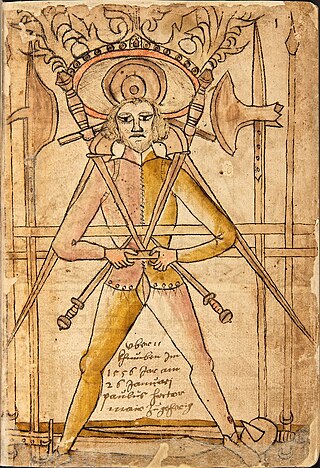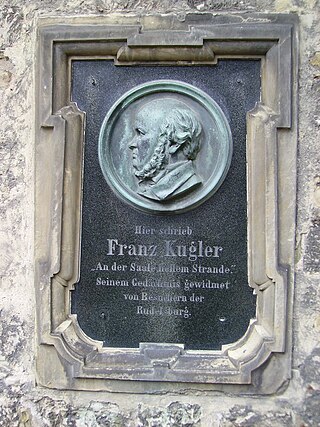Related Research Articles

German literature comprises those literary texts written in the German language. This includes literature written in Germany, Austria, the German parts of Switzerland and Belgium, Liechtenstein, Luxembourg, South Tyrol in Italy and to a lesser extent works of the German diaspora. German literature of the modern period is mostly in Standard German, but there are some currents of literature influenced to a greater or lesser degree by dialects.

Hildegard of Bingen, also known as Saint Hildegard and the Sibyl of the Rhine, was a German Benedictine abbess and polymath active as a writer, composer, philosopher, mystic, visionary, and as a medical writer and practitioner during the High Middle Ages. She is one of the best-known composers of sacred monophony, as well as the most recorded in modern history. She has been considered by a number of scholars to be the founder of scientific natural history in Germany.

Hieronymus Bosch was a Dutch painter from Brabant. He is one of the most notable representatives of the Early Netherlandish painting school. His work, generally oil on oak wood, mainly contains fantastic illustrations of religious concepts and narratives. Within his lifetime his work was collected in the Netherlands, Austria, and Spain, and widely copied, especially his macabre and nightmarish depictions of hell.

A cookbook or cookery book is a kitchen reference containing recipes.

Pseudo-Geber is the presumed author or group of authors responsible for a corpus of pseudepigraphic alchemical writings dating to the late 13th and early 14th centuries. These writings were falsely attributed to Jabir ibn Hayyan, an early alchemist of the Islamic Golden Age.

Johannes Liechtenauer was a German fencing master who had a great level of influence on the German fencing tradition in the 14th century.

Codex 3227a of the Germanisches Nationalmuseum in Nuremberg is a manuscript of 169 folia, dated to the close of the 14th century. Its text is written in Latin and German. The German portions have been identified as in East Central German dialect.

Western calligraphy is the art of writing and penmanship as practiced in the Western world, especially using the Latin alphabet.

Cennino d'Andrea Cennini was an Italian painter influenced by Giotto. He was a student of Agnolo Gaddi in Florence. Gaddi trained under his father, called Taddeo Gaddi, who trained with Giotto.

The so-called Codex Wallerstein or Vonn Baumanns Fechtbuch is a 16th-century convolution of three 15th-century fechtbuch manuscripts, with a total of 221 pages.

The Liber de Coquina is one of the oldest medieval cookbooks. Two codices that contain the work survive from the beginning of the 14th century. Both are preserved at the Bibliothèque Nationale in Paris, France.
Mirrors for princes or mirrors of princes was a literary genre of didactic political writings throughout the Middle Ages and the Renaissance. It was part of the broader speculum or mirror literature genre.

Tegernsee is a town in the Miesbach district of Bavaria, Germany. It is located on the shore of Lake Tegernsee, which is 747 m (2,451 ft) above sea level. A spa town, it is surrounded by an alpine landscape of Upper Bavaria, and has an economy mainly based on tourism.

Mosaic gold or bronze powder refers to tin(IV) sulfide as used as a pigment in bronzing and gilding wood and metal work. It is obtained as a yellow scaly crystalline powder. The alchemists referred to it as aurum musivum, or aurum mosaicum. The term mosaic gold has also been used to refer to ormolu and to cut shapes of gold leaf, some darkened for contrast, arranged as a mosaic. The term bronze powder may also refer to powdered bronze alloy.

Franz Theodor Kugler was an art historian and cultural administrator for the Prussian state. He was the father of historian Bernhard von Kugler (1837-1898).

The anonymous Liber diversarum arcium is a medieval handbook of painting. It contains over 500 art-technological instructions or recipes in Latin, forming a complete structured painting course. It is probably the most substantial and comprehensive mediaeval painters' technical recipe book to survive, and summarises the state of the art in the European workshops of the fourteenth century. In particular it is an important witness to the practice of oil painting before Van Eyck. The majority of the recipes are unique.

Schloss Weimar is a Schloss (palace) in Weimar, Thuringia, Germany. It is now called Stadtschloss to distinguish it from other palaces in and around Weimar. It was the residence of the dukes of Saxe-Weimar and Eisenach, and has also been called Residenzschloss. Names in English include Palace at Weimar, Grand Ducal Palace, City Palace and City Castle. The building is located at the north end of the town's park along the Ilm river, Park an der Ilm. It forms part of the World Heritage Site "Classical Weimar", along with other sites associated with Weimar's importance as a cultural hub during the late 18th and 19th centuries.
Utilis Coquinario is an English cookery book written in Middle English at the turn of the fourteenth century. The title has been translated as "Useful for the Kitchen". The text is contained in the Hans Sloane collection of manuscripts in the British Library and is numbered Sloane MS 468.

The Codex Falkensteinensis is an important medieval manuscript. It was written in 1166 as a feud directory and urbarium by Canons of the Herrenchiemsee monastery, commissioned by the Counts of Neuburg-Falkenstein. Composed at the Neuburg castle near Vagen it is considered the only preserved secular codex from the Hohenstaufen era, the oldest extant book of conveyances from a secular lordship and the oldest European family archive. The original Latin version is preserved in the archives of the Bavarian state, a second Middle High German edition is lost.
The Liber colorum secundum Magistrum Bernardum is a medieval treatise on miniature painting and book illumination. Written in a Medieval Latin interspersed with several expressions in the Italian Lombard dialect it stems from 13th century Northern Italy. The eponymous Magister Bernardus was most likely a cleric working in a scriptorium to whom later collections also attribute further artisanal instructions not related to book painting. It is contained within four manuscripts: